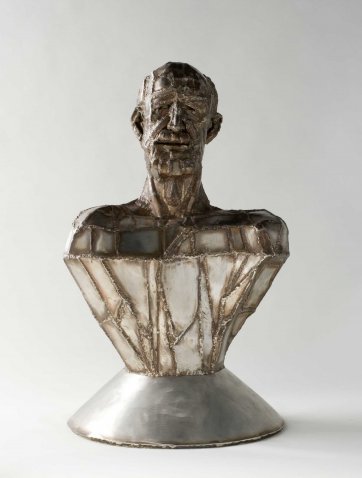I thought it'd be lovely today to chat with you about two of the works that've really popped out for me from the WHO ARE YOU show, which is all about investigating portraiture through many different mediums. And the mediums I've chosen are sculptures.


- I thought it'd be lovely today to chat with you about two of the works that've really popped out for me from the WHO ARE YOU show, which is all about investigating portraiture through many different mediums. And the mediums I've chosen are sculptures.
- [Annette] That first one, Herbert Flugelman, Bert. So I might tell you a little bit about him. So, he came to Australia from Vienna as a refugee from Nazi Germany when he was 15. And he came in spats and plus fours, and he didn't speak any English. And he had such a rough time, because of course he was in the alien detention camp. He had to really reinvent himself and work out, sort of, what it meant to be Australian back in the 1940s. And he went to art school, and then he travelled. And he travelled all over Europe, and he spent two years living in New York, where he spent practically every day at the Metropolitan Museum. And he was aware of the art world around him, and at that point he's calling himself a painter. And then there's this moment for him in the sixties, and I really wanted to read you this quote from him. When his world changed, and I think it was the change that really reverberated through the rest of his practise. He said, "The sixties were very disturbing for me. I saw myself standing there with a palette, beret, and being an 'artist,'" in inverted commas, "and I found it reprehensible. I started to flirt with the idea of making things that were outside the boundaries and that's how I finished up starting on the geometric series. I tried to make things that had to make their own way in the world." And I don't know about you, I love that. It's a kind of, he was the master of experimentation, that he moved away from this idea of absolute figuration, and he is famous, controversially often, for his public sculptures. And so we might look at Ron Mueck's "Two Women." They're here, they are these extraordinary, just exquisite renditions of two elderly women, a pair, looking at, not at us, but their bodies actually mirroring one another in a way. And Ron Mueck was born in Melbourne, 1958. And his family were toymakers, puppeteers. And he, as I said, didn't actually manage to get into art school. But he created a whole career working in modelling and sets. So he worked for Bill Henson with "The Muppets." He lived in New York for decades. And then Paula Rego, great British artist, Portuguese British artist, who actually became his mother-in-law, invited him to make a work for her show. And it's a tiny figure of Pinocchio, and it's just sublime. It was the same year that he made the work "Dead Dad," which was a sensation at the Sensation show in the UK. So, you look at these two women and that immediately blasted out of the water because there is a narrative here, which is really interesting. They've been variously described, their gesture and their facial expressions, as "simmering suspicion," as being spiteful or... There's a kind of negativity in the way that they are actually turning the tables, they're looking at us, the visitor to that exhibition, rather than us entirely viewing them.
- What I like is the, for me when I see a work like this, or Ron Mueck's work, is that it is so lifelike. But the scale changes it immediately, 'cause they are so tiny or so enormous. And they're so real that you just go emotionally there.
- [Annette] Yes.
- So you just go, I don't initially go, "Wow, they're so lifelike." You just have an emotion connection, reaction, you feel it. And then you get closer and it's like, "How can..." That blows my mind that anyone could make something like that. But you've already felt, you're going through that kind of emotional journey, or you're creating a story. And maybe in some ways these two women are like mirrors. So, they don't look very nice, and yet maybe we're not very nice either. So maybe in fact, that's us in the gallery. Leaning in, going "nyah nyah nyah nyah."
- [Annette] I think that's so true.
- At everyone else. Not, you know, not the best of us.
- Yeah, I think that's absolutely the point. And I think that's part of the hook, is that we're not just observing something, it's actually back to us.
- [Marina] Yeah.
- And so I think that many people have commented on looking at his sculpture, whether it was "Dead Dad" or the "Pregnant Woman" or whatever, that in fact there has been some kind of reflection of their own life experience within that.
- Yeah.
- And this is a perfect, perfect little bundle of judgement here, and of course we all do that. So, yeah.













